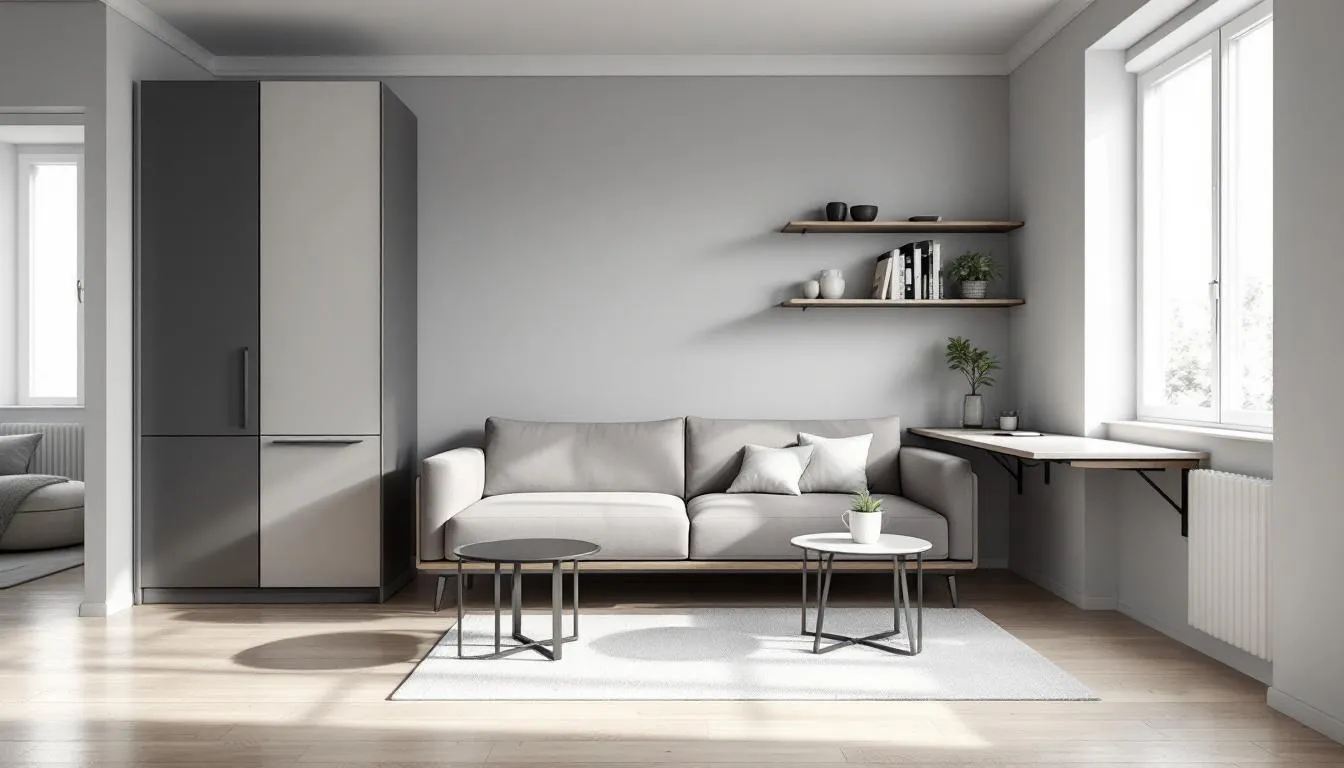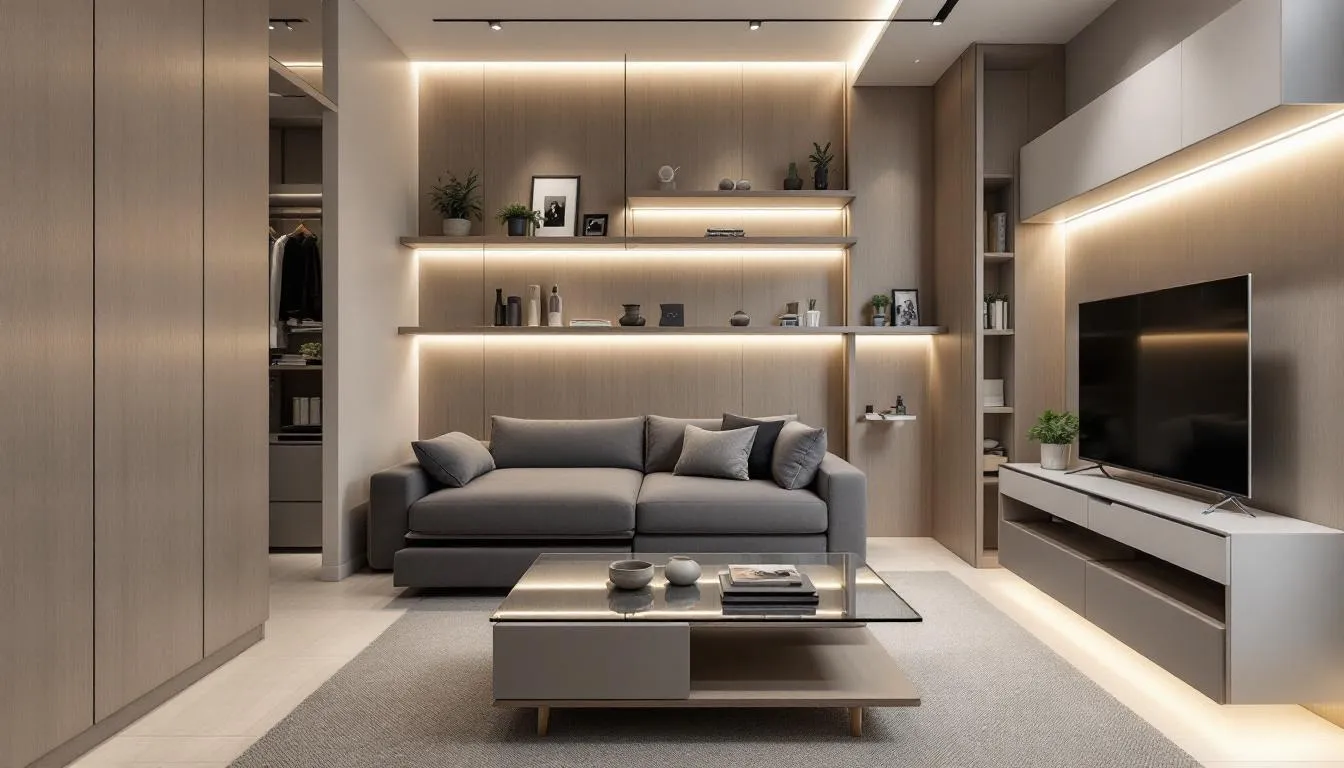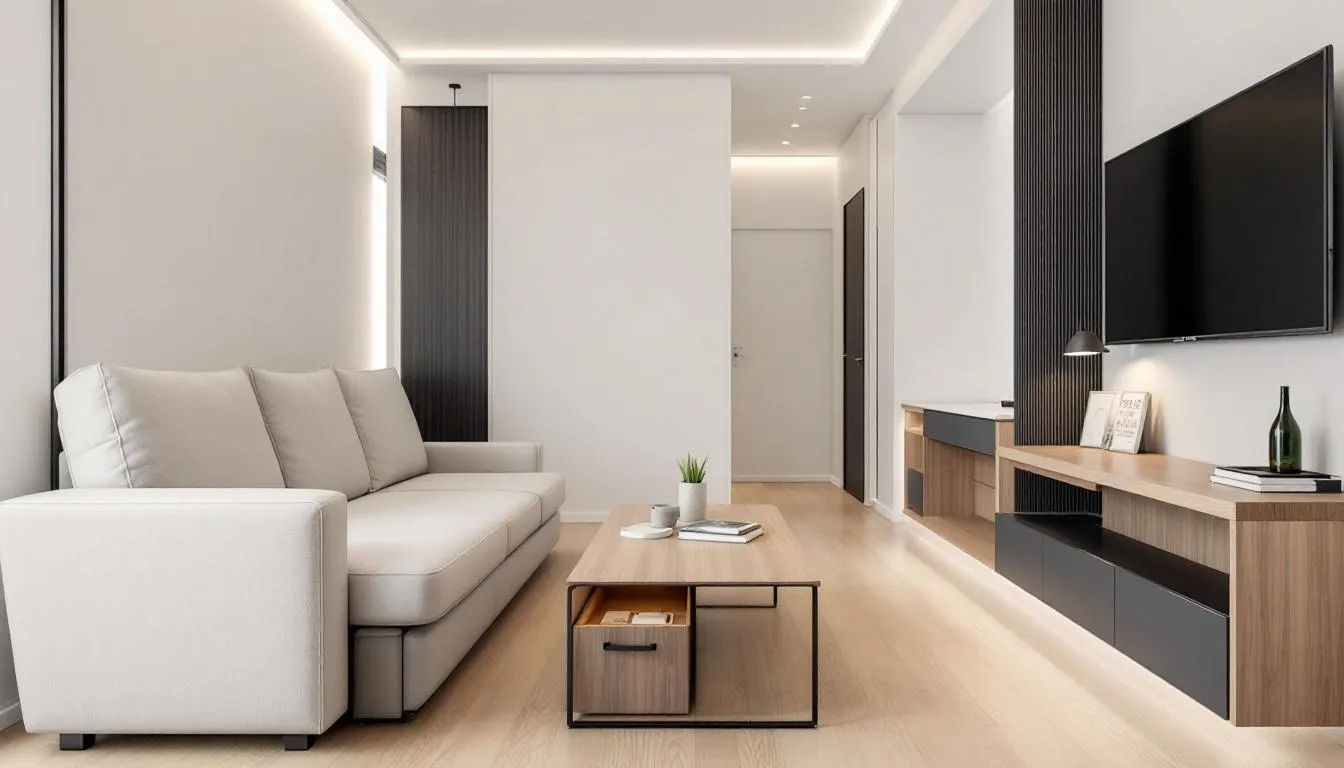When we moved into our small apartment, we quickly saw how important smart planning was. With limited space, every detail mattered—from furniture to layout, color, and decor. We had to be intentional to create a space that felt open and inviting.
One major takeaway was the impact of scale and layout. Choosing the right-sized furniture and arranging it for easy movement helped us design a space that felt cozy yet much bigger than it was. Thoughtful design highlighted the room’s features while blending style and function.
Using color, light, and texture wisely made a big difference. A simple color scheme, multipurpose furniture, and well-placed lighting helped open up the space and add character.
With the right approach, even the smallest living room can become a stylish, functional space that fits your needs. Explore small living room ideas to make the most of your space.
Understanding the Space Before You Begin
Before choosing furniture or decor, it’s important to fully understand your space. Small living rooms can feel warm and inviting, perfect for close gatherings, but they also require careful planning. Knowing the room’s dimensions, layout, and lighting will guide your design decisions and help you use the space effectively.
Furniture scale is key. Large, bulky pieces can overwhelm a small room, so it’s better to choose furniture that fits well and leaves room for easy movement. This creates a more open, comfortable layout that feels balanced and uncluttered.
Light colors and sleek furniture can make the space feel brighter and more expansive. Neutral tones reflect natural light and keep the room from feeling closed in. When you work with your space instead of against it, even design challenges become creative opportunities.
Keep pathways clear and use smart storage solutions to maintain both function and style. For design inspiration tailored to smaller spaces, platforms like Dreamr offer ideas that blend style with practical living. Thoughtful planning and arrangement can transform any small living room into a well-organized, stylish, and comfortable space.
Choosing the Right Layout for Comfort and Function

The layout of your living room plays a pivotal role in how comfortable and functional the space feels. Planning a flexible layout is key for a small living room, enabling adaptation to different needs and activities. Well-arranged living room furniture can enhance both aesthetics and usability without cluttering the space. Exploring stylish and space-saving options from Nova Furnishing can help you find pieces that fit perfectly and elevate your living area.
Traffic flow and zoning within the living room are vital considerations. To ensure the room does not feel cramped and overcrowded:
- Ensure there are clear pathways for movement.
- Carefully plan the placement of each piece of furniture.
- Create a natural flow.
- Maximize space.
Incorporating multifunctional furniture can be a game-changer in smaller spaces. Pieces that serve multiple functions, like a sofa bed or an ottoman with storage, can save space and add to the room’s versatility, enhancing both functionality. Additionally, using room dividers or different seating arrangements can help define areas within the living room, creating a more organized and spacious feel.
Consider the visual weight and balance of your space by:
- Placing larger items against the walls
- Keeping the center of the room more open to create the illusion of a larger space
- Thoughtfully arranging your furniture
- Utilizing flexible layouts to create a small living room that is both comfortable and functional.
Making Furniture Work Harder in a Small Space

In a small living room, every piece of furniture needs to pull its weight. Selecting furniture that serves multiple purposes can maximize usability in compact areas. For instance, opting for a living sofa from Grafunkt that converts into a bed or includes hidden compartments can provide additional sleeping space and storage without taking up extra room.
Slim and minimalist furniture designs help maintain an open and airy feel in small rooms. Incorporating built-in furniture, like benches or shelves under windows, can enhance storage and seating options in limited spaces. Wall-mounted floating shelves are another great way to utilize vertical space effectively, keeping the floor area clear and maximizing space. If you want to optimize your storage solutions, consider how to install floating shelves for added functionality.
Furniture with hidden storage offers several benefits:
- Adds functionality while reducing clutter.
- Can store items like remote controls, magazines, or blankets, keeping the living room tidy and organized.
- Furniture with legs that lift it off the ground can create an illusion of more space in smaller areas, providing extra storage.
Designing spaces with furniture placement against walls can optimize floor space for movement. Making your furniture work harder allows you to create a small living room that is both stylish and highly functional without sacrificing comfort or aesthetics.
Using Color, Light, and Texture to Your Advantage
Color, light, and texture can completely transform a small living room. A simple color scheme helps the space feel larger by creating a smooth, unified look. To keep things visually interesting, layering textures within a light palette adds depth and warmth without overwhelming the room.
Light-colored walls reflect natural light, making the room feel open and airy. Adding a large mirror can double the sense of space by bouncing light and creating the illusion of depth. Reflective surfaces also help brighten the room and enhance its overall openness.
To make a small space feel bigger, try these tips:
- Stick to a monochromatic color palette for a seamless, spacious look
- Use soft tones and glossy surfaces to reflect light
- Mix furniture heights for variety and a more dynamic layout
Layered lighting—from floor and table lamps to sconces—adds warmth and helps define the space. Let natural light shine in with sheer curtains to create a bright, inviting feel. With thoughtful use of color, light, texture, and lighting, even a compact living room can feel stylish, open, and comfortable.
Conclusion
Maximizing a small living room starts with smart planning. Understanding your space and its limits helps you make choices that boost both comfort and usability. Furniture selection is key. Opt for multifunctional pieces like sofa beds or ottomans with hidden storage to add flexibility without crowding the room. Arranging furniture to allow clear pathways and using adaptable layouts helps keep the space open and practical.
Color, lighting, and texture also make a big impact. Light tones, reflective surfaces, and layered lighting can make the room feel brighter and more spacious. Mixing textures and varying furniture heights adds depth and character. With a bit of creativity and thoughtful design, your small living room can be both stylish and functional—perfectly suited to your lifestyle.
Frequently Asked Questions
How can I make my small living room look bigger?
To make your small living room look bigger, opt for lighter colors, incorporate reflective surfaces, and choose multifunctional furniture. These tricks can really give your space an open, airy feel!
What are some essential furniture pieces for a small living room?
For a small living room, prioritize multifunctional furniture like sofa beds and storage ottomans to maximize space and utility. These pieces not only save room but also add practicality to your decor.
How should I arrange furniture in a small living room?
For a small living room, prioritize open pathways and choose a flexible layout to keep the space looking open and functional. This will enhance both the aesthetics and usability of your room.
What color scheme works best for small living rooms?
Light and neutral colors are your best bet for small living rooms, as they help to enhance the sense of space and create a cohesive flow. Stick with soft shades to make your room feel larger and more inviting!
Are there any specific design principles for maximizing small living spaces?
Absolutely! To maximize small living spaces, focus on utilizing vertical space, keeping things clutter-free, and selecting purposeful furniture that enhances both style and functionality.

